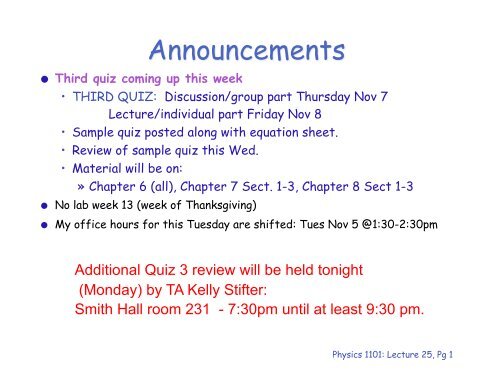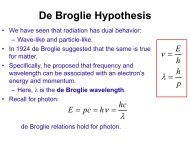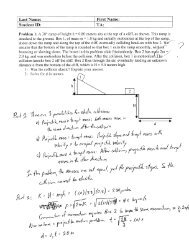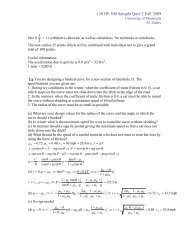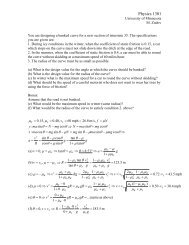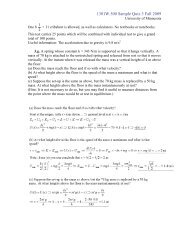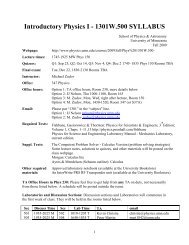Additional Quiz 3 review will be held tonight (Monday) by TA Kelly ...
Additional Quiz 3 review will be held tonight (Monday) by TA Kelly ...
Additional Quiz 3 review will be held tonight (Monday) by TA Kelly ...
You also want an ePaper? Increase the reach of your titles
YUMPU automatically turns print PDFs into web optimized ePapers that Google loves.
Checking UnderstandingWhich spring has the largest spring constant?Physics 1101: Lecture 25, Pg 5
Example ProblemWhat is the net force on the block if it is moved 15 cm to the rightof its equilibrium position?Physics 1101: Lecture 25, Pg 7
Is the equivalent spring constant in parallel:k 1 k 2A. More than the equivalent spring constantin seriesB. Less than the equivalent spring constantin seriesC. Equal to the equivalent spring constantin seriesTake out a note card and draw the force diagrams onthe block. See if you can figure out the formula for theequivalent spring constant in parallel.Physics 1101: Lecture 25, Pg 8
Check UnderstandingIf you cut a spring in half to make two springs, what is thespring constant for each smaller spring?A. Twice the spring constant for the whole springB. Half the spring constant for the whole springC. The same as the whole spring.D. none of the above.Physics 1101: Lecture 25, Pg 10
Spring DemoThe two situations shown have springs with the same springconstant, k, and an equilibrium length of 11 cm. What is thedifference in the total displacement of the spring <strong>be</strong>tween thetwo situations?Take out a note card and write down which you think has thegreater total spring displacement or are they both the same.Why? Discuss with your neighbor when done.BA18N18N18NC – both springs same displacementPhysics 1101: Lecture 25, Pg 12
Remem<strong>be</strong>r this??The tension was the same – so for springs, the displacementfrom equilibrium is same. (Ropes are like very stiff springs).Ropes and Pulleys DemoWhat is the difference in the rope’s tension <strong>be</strong>tweenthe two situations?ABPhysics 1101: Lecture 25, Pg 13
Checking UnderstandingBill tests out a spring and sees that if he attaches it to a wall and pullswith a force of 200 N, the spring stretches <strong>by</strong> 20 cm from its equilibriumposition.Hmm.. 200 N makesit 20 cm longer.Bill and Carlos then have a tug of war with the spring. Each pulls onhis end of the spring with a 200 N force. The center of the spring staysin the same x position. What is the displacement at Bill’s end?A. 5 cm B. 10 cmC. 15 cm D. 20 cmPhysics 1101: Lecture 25, Pg 14
Checking UnderstandingBill tests out a spring and sees that if he attaches it to a wall and pullswith a force of 200 N, the spring stretches <strong>by</strong> 20 cm from its equilibriumposition.Hmm.. 200 N makesit 20 cm longer.Bill and Carlos then have a tug of war with the spring. Each pulls onhis end of the spring with a 200 N force. The center of the spring staysin the same x position. What is the displacement at Bill’s end?Carlos is acting like the wall here, with the spring pulling back on me with 200 N force.So the total displacement is the same, 20 cm.A. 5 cm B. 10 cmC. 15 cm D. 20 cmBut to keep the center of spring in the same xposition, both Carlos and I must havestepped back an equivalent distance whenwe pulled. So to make a total of 20 cm, eachof us stepped back 10 cm.Physics 1101: Lecture 25, Pg 15
Example Problem 8.7The figure shows a spring attached to a 2.0 kg block. The other end ofthe spring is pulled <strong>by</strong> a motorized toy train that moves forward at 5.0cm/s. The spring constant is 50 N/m, and the coefficient of static friction<strong>be</strong>tween the block and the surface is 0.60. The spring is at its equilibriumlength at t=0s when the train starts to move. When does the block slip?Physics 1101: Lecture 25, Pg 16


